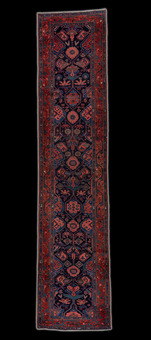Antique wide runner No. 61974 Hamadan, ca. 1930 Iran 462 x 102 cm

Larger images (will open in new window)
Please click on the thumbnails below for a larger view
| main view |
Image 2 |
Image 3 |
Image 4 |
Image 5 |
 |
 |
 |
 |
 |
| Item Number: |
61974 |
| Name: |
Hamadan, ca. 1930 |
| Country†of†Origin: |
Iran |
| Size: |
462 x 102 cm (runner) |
| Made:
|
ca. 1930 |
| Pile: |
wool |
| Design: |
geometric / allover |
| Ground Color: |
dark blue / navy / rosť / red |
| Remarks: |
This is a unique handmade / hand-knotted / traditional oriental carpet
The pile of this carpet is made of wool
This carpet is in good condition despite its age. |
 add to cart
add to cart
More about the provenance Hamadan, ca. 1930 | Iran
Hamadan (also: "Hamedan") is one of the oldest cities of Persia. The former name of Hamadan used to be "Ekbatan", this term is still used to this day for higher quality manufactory rugs from the region (also called "Hamadan Shahrbaf"). Ekbatan was the main city of the tribe of the "Meder". Ekbatan or Hamadan Shahrbaf rugs are relatively heavy rugs with a high pile. The majority of Hamadan rugs are peasant or nomadic rugs - with several sub-provenances such as Bibikabad, Borchalou, Darjazin and Hosseinabad amongst others. Hamadan rugs are mainly woven with the Turkish knot.
This is an Oriental nomadic rug. The word "nomad" comes from the Greek word "nemein". Nomads are wandering tribes, shepherds, stockbreeders, or hunters. In the minorly populated areas of Asia and North Africa they move with their herds, all their belongings and their tents to new places constantly. Many states already tried to make them settle down with various success. Mostly it is the women of the tribes which contribute to the family's income with their carpet knotting and weaving while the men breed stock or go hunting. But due to the circumstances of nomadic life the carpet production often lacks regularity and precision in form and design, which actually adds to their originality and makes them even more popular. The wool is mostly dyed with vegetable dyes.

